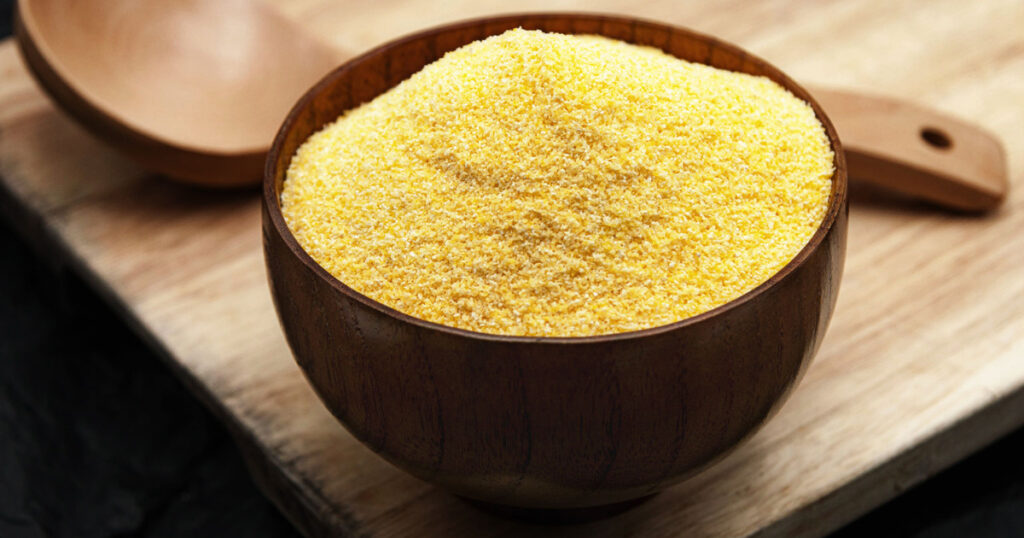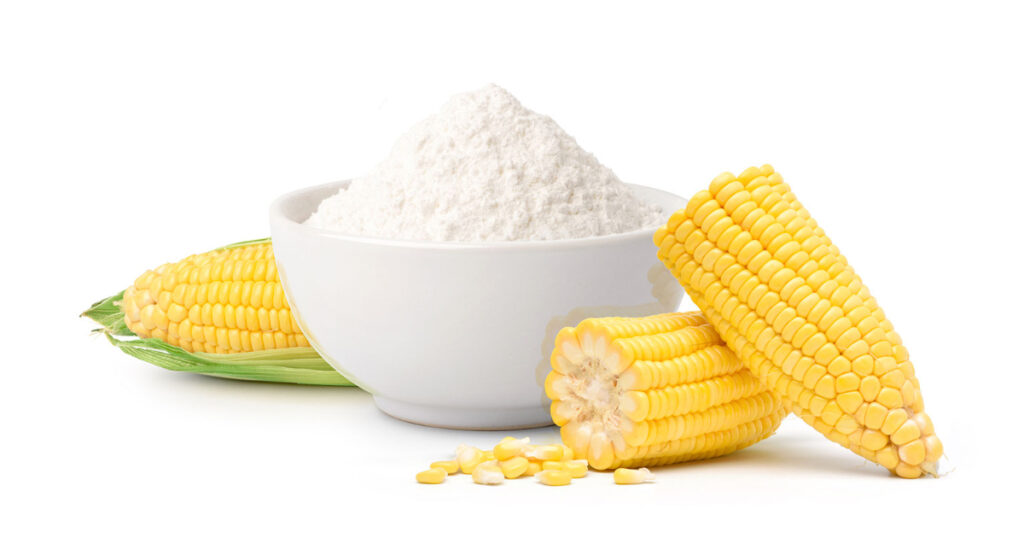Corn-based ingredients like cornmeal, corn flour, and cornstarch are pantry staples used in cooking and baking. But what’s the difference between them?
While all three derive from corn, they vary in texture, taste, and uses. Understanding how they differ allows you to use the right one for your recipe.
What is Cornmeal?

Cornmeal is a coarsely ground flour made from drying and pulverizing whole corn kernels. The grind size ranges from fine to coarse.
The coarser cornmeal has a more pronounced corn flavor and gritty texture. Finely ground cornmeal is smoother with a less intense corn taste.
Cornmeal comes in different colors depending on the corn variety, including yellow, white, and blue cornmeal.
You’ll commonly find yellow and white cornmeal. Blue cornmeal has a richer corn flavor but may be harder to find.
Uses:
- Polenta
- Cornbread
- Corn muffins
- Pizza dough
- Coating for frying
Cornmeal adds great flavor and texture to baked goods. Its slightly gritty excellence makes it perfect for breading fried foods.
What is Corn Flour?

Corn flour refers to finely ground powder made from whole dried corn kernels. It comes in white or yellow corn flour varieties.
Unlike coarsely textured cornmeal, corn flour has a fine, floury texture like all-purpose flour.
Uses:
- Gluten-for delicate baking
- Batters
- Breading
- Frying
Corn flour contains more nutrients than cornstarch since it uses the whole corn kernel. Its mild corn flavor works well in baked goods.
Use it like you would all-purpose flour for breading and frying foods. The fine grind gives foods a deliciously crispy crust.
What is Cornstarch?

Cornstarch comes from the starchy endosperm of the corn kernel. Producers remove the protein and hull, leaving only the powdery starch.
It has a white, chalky appearance and a smooth, silky texture. Cornstarch is flavorless, making it ideal for thickening without altering the taste.
Uses:
- Thickening agent
- Pie fillings
- Cobblers
- Fruit pies
Mix cornstarch with cool water before adding it to hot liquids to prevent clumping. Its thickening power makes it essential for smooth, lump-free gravies and sauces.
A dusting of cornstarch can help coat foods to seal in moisture for crispy baked goods with a tender interior.
Cornmeal vs. Corn Flour vs. Cornstarch: Key Differences
While all three come from corn, key differences set them apart:
- Texture: Cornmeal is coarse, corn flour is finely ground, and cornstarch is a silky powder.
- Flavor: Cornmeal and corn flour have a mild corn flavor. Cornstarch is neutral-tasting.
- Uses: Cornmeal for breading and baking, corn flour for gluten-free flour, cornstarch to thicken.
- Nutrition: More nutrients in cornmeal and corn flour vs. pure starch.
Understanding what sets them apart allows proper use in recipes. Using the wrong one could ruin your dish!
Can You Substitute Cornstarch, Corn Flour, and Cornmeal?
These corn-based ingredients aren’t easily swappable due to differences in texture and purpose. However, in a pinch, here are some substitutions:
- Cornstarch: Substitute arrowroot, tapioca, or potato starch. Or use flour by doubling the amount.
- Corn flour: Replace with Masa Harina or fine cornmeal. Or use all-purpose flour.
- Cornmeal: Substitute polenta or semolina. Or use fine corn flour.
Adjust the liquid in your recipe with substitutions to account for texture changes. Tested recipes perform best with the exact ingredients listed.
How to Store Cornmeal, Corn Flour, and Cornstarch
To retain freshness, store corn-based ingredients properly:
- Keep in airtight containers in a cool, dry place.
- Cornmeal is more prone to rancidity. Refrigerate or freeze for longer life.
- Properly stored corn flour and cornstarch last one year. Cornmeal lasts 6-12 months.
- Heat and humidity shorten shelf life.
What’s the Difference Between Corn Flour and Cornstarch?
It’s easy to confuse corn flour and cornstarch.
But they differ in key ways:
- Corn flour uses the entire corn kernel. It contains protein, fiber, vitamins, and minerals.
- Cornstarch comes just from the starchy endosperm, so it’s mainly carbohydrates.
- Corn flour has a sweet, nutty corn flavor. Cornstarch is flavorless.
- Corn flour works well in baked goods and as a cornstarch substitute. Cornstarch excels as a thickener.
What’s the Difference Between Yellow and White Cornmeal?
Yellow and white cornmeal are quite similar. The main differences are:
- Yellow cornmeal has a richer corn flavor and aroma compared to white.
- Yellow cornmeal has a slightly coarser texture than more finely ground white.
- White cornmeal has a milder flavor.
- The color difference comes from yellow corn containing more carotenoids compared to white.
- Nutritionally they are similar, though yellow may contain slightly more vitamin A from carotenoids.
- Either can be used interchangeably in recipes calling for cornmeal.
What Dishes Use Cornstarch?
Cornstarch is a versatile thickener used in many dishes:
- Gravies and sauces – it evenly thickens without clumping.
- Pie fillings and fruit pies – prevent watery fillings.
- Cobblers – thicken the fruit filling.
- Soups and stews – add body and richness.
- Asian stir-fries – thickens the sauce and coats meat.
- Fried foods – seals moisture and provides a crispy coating.
Its neutral taste allows thickening across sweet and savory dishes without affecting flavors.
How Does Corn Flour Help Gluten-Free Baking?
Corn flour benefits gluten-free baking in several ways:
- It adds a gritty texture and a wholesome corn flavor.
- The fine grind gives more structure than coarser cornmeal.
- It contains protein to help baked goods rise better than starchy cornstarch.
- The mild corn taste works well in both sweet and savory baked goods.
- It adds nutrition like fiber, vitamins, and minerals lacking in all-purpose flour.
- Its light texture won’t overwhelm other ingredients in recipes.
While lacking gluten, corn flour adds moisture, structure, and corn flavor to gluten-free treats.
Frequently Asked Questions
Can I substitute cornstarch for corn flour or cornmeal?
No, you cannot substitute cornstarch for corn flour or cornmeal. Cornstarch thickens while corn flour and cornmeal add texture.
Is corn flour gluten-free?
Corn flour is 100% gluten-free since it does not contain wheat or gluten proteins. This makes it a useful substitute for wheat flour.
What’s the difference between corn flour and cornmeal?
Corn flour is more finely ground than gritty cornmeal. So corn flour has a soft, floury texture, while cornmeal is coarser.
Is corn flour the same as cornstarch?
No. Corn flour uses the whole corn kernel, so it contains more nutrients. Cornstarch is just the starchy part of corn, so mainly carbs.
Can I use corn flour to bake?
Yes, corn flour works great in baked goods. You may need to adjust other ingredients to account for the lack of gluten, but corn flour adds nutrition and corn flavor.
Conclusion
While cornmeal, corn flour, and cornstarch originate from corn, understanding their unique characteristics allows proper recipe use. Correct identification prevents baking mishaps!
Their differences come down to texture, taste, and purpose. Proper storage retains freshness and shelf life. With the right know-how, you can use the ideal corn product for whatever dish you want.

